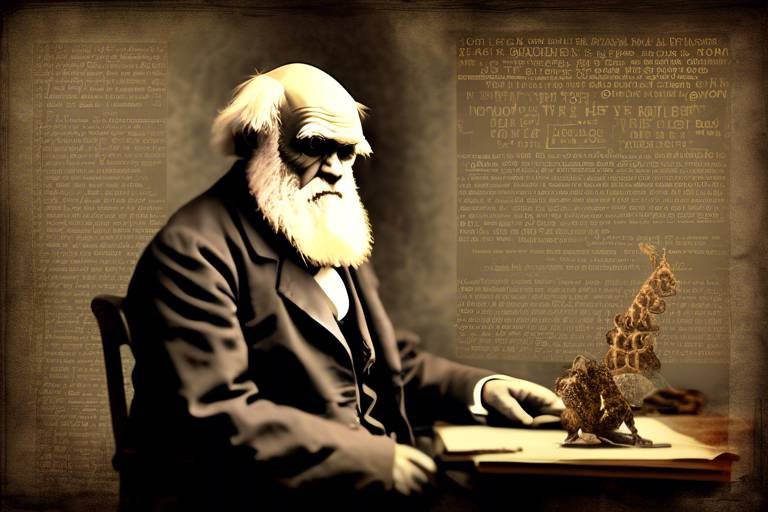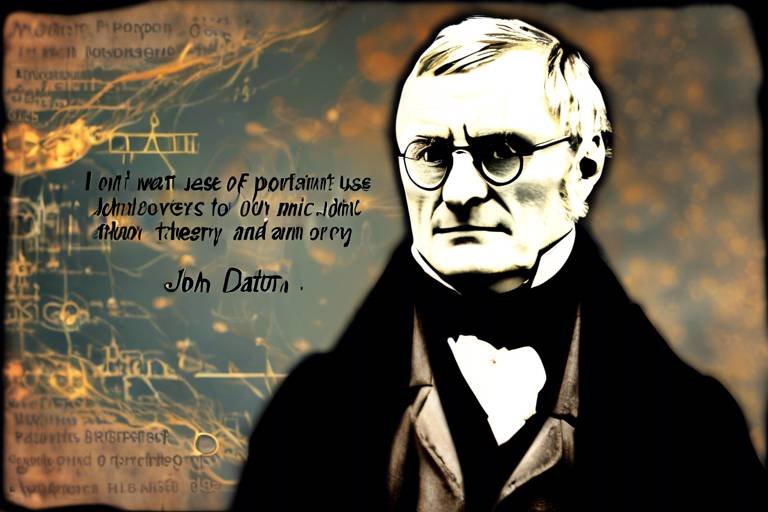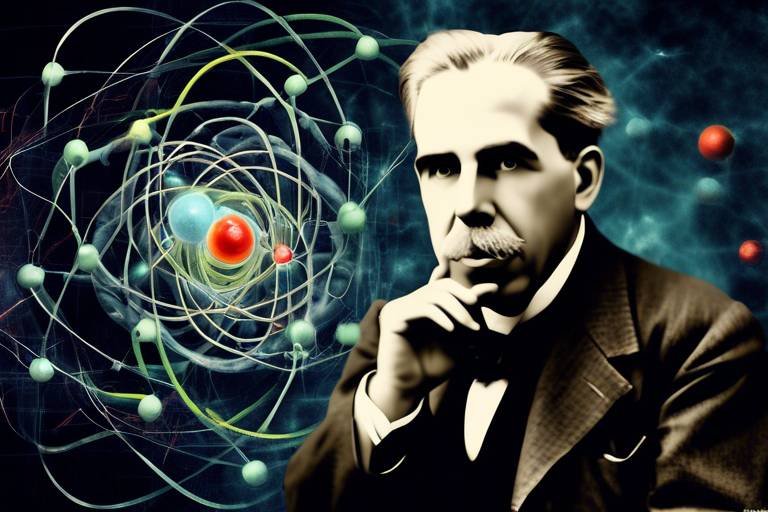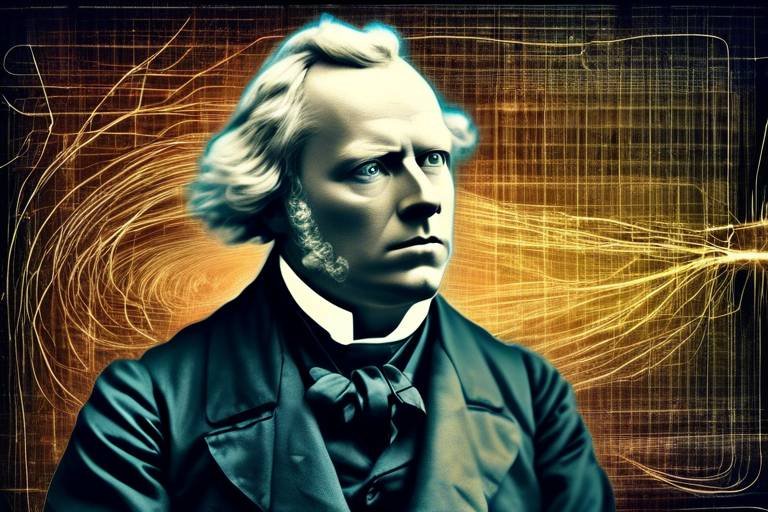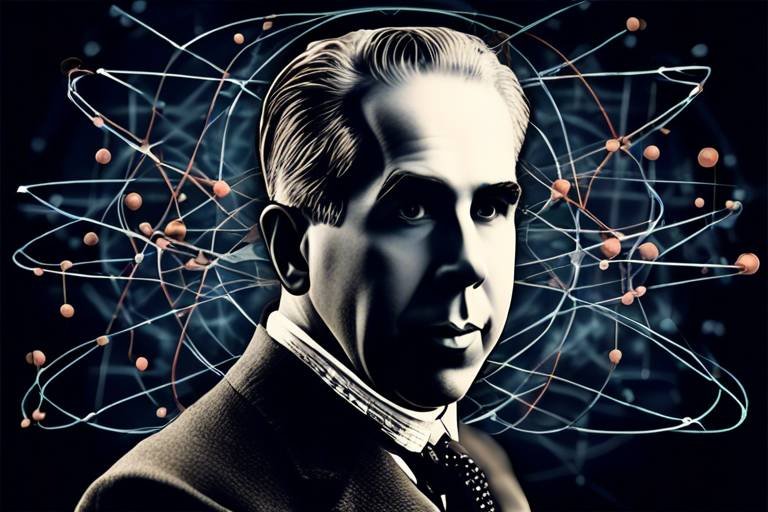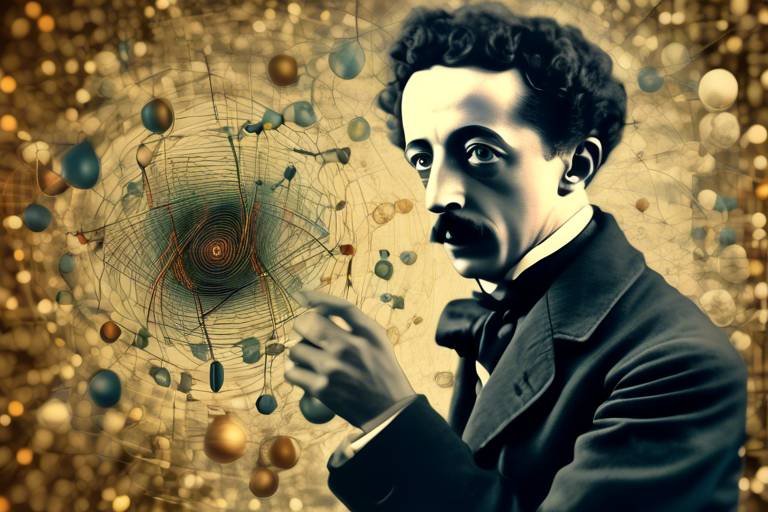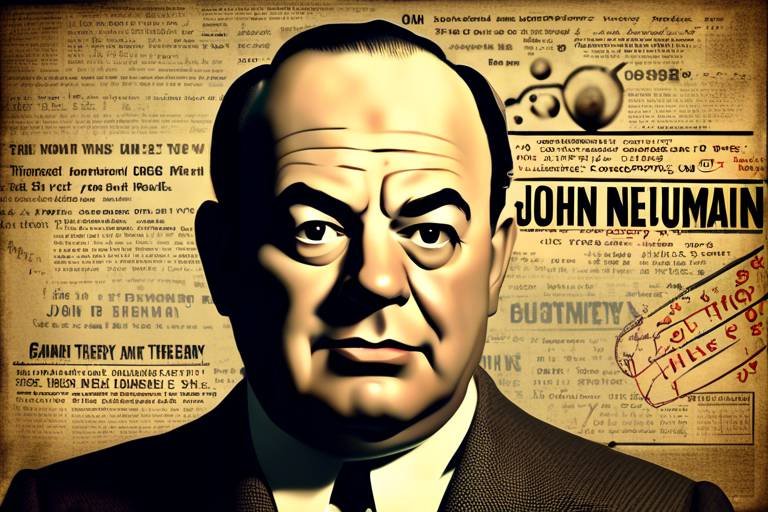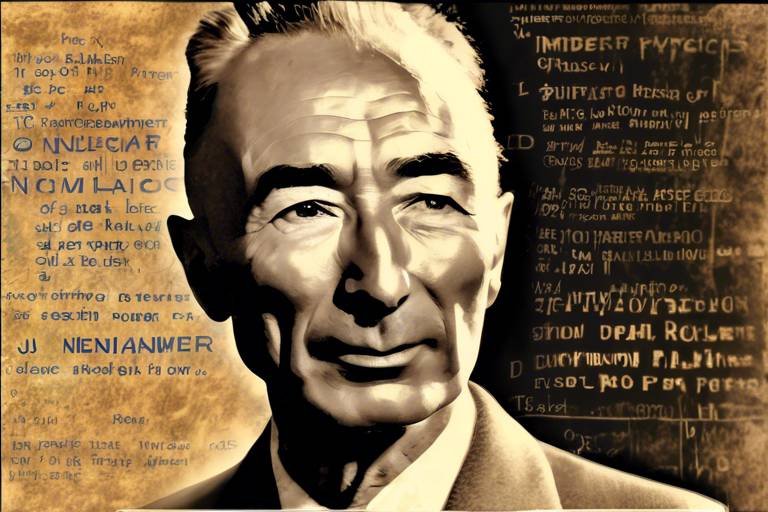The Contributions of Johannes Gutenberg to the Printing Revolution
When we think about the transformation of knowledge and culture during the Renaissance, one name stands out: Johannes Gutenberg. His contributions to the world of printing were nothing short of revolutionary, igniting a fire that would spread across Europe and beyond. Imagine a world where books were rare treasures, locked away in monasteries, accessible only to the elite. Gutenberg shattered that barrier with his groundbreaking innovations, making literature and information available to the masses. This article delves into the profound impact of his work, exploring how his inventions not only changed the way we produce books but also altered the very fabric of society.
At the heart of Gutenberg's contributions lies the invention of the movable type printing press. This ingenious device allowed for the rapid production of printed materials, drastically reducing the time and cost associated with creating books. Prior to Gutenberg's press, each book was painstakingly copied by hand, often taking years to complete. With his innovation, a single press could produce hundreds of copies in a matter of days. This was a game changer! Suddenly, books became accessible and affordable, leading to an explosion of information and ideas across Europe. The printing press was not just a tool; it was a catalyst for change, enabling the spread of knowledge like never before.
One of the most significant achievements of Gutenberg's printing press was the production of the Gutenberg Bible. Printed in the 1450s, this masterpiece was the first major book produced using movable type. It was more than just a religious text; it was a symbol of the potential of printing technology. The Gutenberg Bible showcased the intricate design and craftsmanship that could be achieved, setting a new standard for book production. Its creation marked a significant milestone in the history of literature, as it demonstrated that books could be produced in quantities that were previously unimaginable.
The design and features of the Gutenberg Bible were revolutionary for their time. It utilized high-quality paper and ink, which not only enhanced the visual appeal but also ensured durability. The text was printed in a clear, legible typeface, making it easier for readers to engage with the material. The careful attention to detail in its production reflected the technological advancements of the period and set new benchmarks for future publications.
Beyond its textual significance, the aesthetic appeal of the Gutenberg Bible cannot be overlooked. With its intricate illustrations and ornate typography, it was a feast for the eyes. This artistic quality not only highlighted the capabilities of the printing press but also attracted a wider audience to printed works. People were drawn to the beauty of the pages, which encouraged them to explore literature and religious texts, fostering a culture of reading.
The production of the Gutenberg Bible played a crucial role in increasing literacy rates. As more people gained access to religious texts and educational materials, the thirst for knowledge grew. No longer were books the exclusive domain of the wealthy; they became tools for the common man. This democratization of knowledge laid the groundwork for a society that valued education and learning, ultimately transforming the intellectual landscape of Europe.
Gutenberg's printing press didn't just change how books were made; it also facilitated the rapid spread of ideas. The ability to print pamphlets, essays, and books allowed thinkers and writers to challenge traditional authority and engage in intellectual discourse. This was a time when ideas could travel faster than ever, igniting movements and inspiring change. The printing press became a powerful vehicle for the exchange of thoughts, leading to a more informed and engaged populace.
One of the most profound impacts of Gutenberg's innovations was their role in the Protestant Reformation. Printed materials became essential for reformers like Martin Luther, who used the press to disseminate their ideas widely. This accessibility allowed them to reach a broad audience, challenging the established church and sparking significant religious and societal changes. The printing press was not just a tool for communication; it was a weapon for reform, empowering individuals to question authority and seek truth.
The printing of pamphlets and treatises became a powerful tool for reformers during this period. These short, impactful publications allowed them to communicate their messages effectively and rally support for their causes across Europe. The speed and efficiency of the printing press meant that ideas could spread like wildfire, igniting debates and discussions that would shape the future of Europe.
The accessibility of printed materials transformed education in ways that were previously unimaginable. As books became more available, schools and universities began to emerge, fostering a culture of learning that would shape future generations. Education was no longer a privilege reserved for the few; it became a right for many. This shift laid the foundation for the modern educational system, emphasizing the importance of literacy and critical thinking.
- What was Johannes Gutenberg's most significant invention?
Gutenberg's most significant invention was the movable type printing press, which revolutionized the production and distribution of printed materials.
- How did the Gutenberg Bible impact society?
The Gutenberg Bible made literature more accessible, contributing to increased literacy rates and fostering a culture of reading and education.
- What role did the printing press play in the Protestant Reformation?
The printing press allowed reformers to spread their ideas widely, challenging traditional authority and leading to significant religious changes.

The Invention of the Printing Press
Imagine a world where books were rare treasures, locked away in monasteries, and the written word was a privilege reserved for the elite. This was the reality before Johannes Gutenberg stepped onto the stage of history with his remarkable invention: the movable type printing press. Developed in the mid-15th century, Gutenberg's printing press was nothing short of a revolutionary breakthrough that changed the landscape of knowledge dissemination forever.
The essence of Gutenberg's invention lay in its ability to produce multiple copies of text quickly and efficiently. Prior to this, books were painstakingly copied by hand, a laborious process that could take months or even years to complete. With the introduction of movable type, individual letters could be arranged to form words, allowing for the rapid printing of entire pages. This innovation not only lowered the cost of book production but also made printed materials accessible to a much wider audience.
To understand the significance of the printing press, consider its impact on society. Before Gutenberg's invention, the majority of the population was illiterate, with only a small fraction able to read and write. The printing press changed this dynamic dramatically. Suddenly, books were no longer exclusive to the wealthy; they became available to the middle class and even the poor. This accessibility sparked a literacy revolution that empowered individuals to educate themselves and engage with new ideas.
Furthermore, the printing press facilitated the spread of information like never before. Ideas that had once been confined to local communities could now travel across borders and reach far-flung regions. The ability to print pamphlets and flyers meant that news, opinions, and revolutionary thoughts could circulate rapidly, igniting discussions and debates that shaped the course of history.
In a time when the Catholic Church held immense power, the printing press became a tool for change. Religious texts, previously controlled and interpreted by clergy, could now be printed and distributed widely, allowing individuals to interpret scripture for themselves. This shift not only challenged the Church's authority but also laid the groundwork for the Protestant Reformation.
| Impact of the Printing Press | Before Gutenberg | After Gutenberg |
|---|---|---|
| Access to Books | Limited to the wealthy and religious institutions | Widespread availability for all social classes |
| Literacy Rates | Low literacy, primarily among the elite | Increased literacy as books became affordable |
| Spread of Ideas | Slow and localized | Rapid and global dissemination of information |
| Religious Authority | Controlled by the Church | Challenged by access to printed Bibles and texts |
In summary, the invention of the printing press by Johannes Gutenberg was a monumental leap forward in human communication. It transformed the way knowledge was shared and consumed, paving the way for the Renaissance and the modern world as we know it. The ripple effects of this innovation continue to be felt today, as we navigate an age where information is at our fingertips, thanks in large part to the groundwork laid by Gutenberg.
- What was the printing press? The printing press was a machine that used movable type to print text quickly and efficiently, revolutionizing the production of books.
- How did the printing press affect literacy? The printing press made books more accessible and affordable, leading to increased literacy rates among the general population.
- What was the significance of the Gutenberg Bible? The Gutenberg Bible was the first major book printed using movable type, showcasing the potential of printing technology and marking a significant milestone in literature.

The Gutenberg Bible
The Gutenberg Bible, printed in the 1450s, stands as a monumental achievement in the history of literature and printing. Often regarded as the first major book produced using movable type, it not only demonstrated the revolutionary potential of Gutenberg's printing press but also marked a significant turning point in the accessibility of knowledge. Before this innovation, books were painstakingly copied by hand, making them rare and expensive commodities, accessible only to the wealthy and powerful. With the advent of the printing press, the landscape of information dissemination began to change dramatically, much like how the internet transformed communication in the late 20th century.
One of the most fascinating aspects of the Gutenberg Bible is its design and features. Crafted with meticulous attention to detail, it utilized high-quality paper and ink, which set new standards for book production. The text was printed in a clear and legible typeface, allowing readers to engage with the material more easily than ever before. This was a game-changer, as it not only enhanced readability but also encouraged a broader audience to delve into the world of printed literature.
The design of the Gutenberg Bible was not just a technical feat; it was an artistic endeavor as well. The pages were adorned with intricate illustrations and ornate typography, showcasing the artistic capabilities of the printing press. This aesthetic appeal drew in a wider audience, who were captivated not only by the content but also by the beauty of the book itself. Imagine walking into a library filled with hand-copied texts, only to discover a vibrant, beautifully printed book that practically beckons you to explore its pages. This allure helped to transform reading from a privilege of the elite to a pastime for the masses.
Moreover, the aesthetic qualities of the Gutenberg Bible played a crucial role in its impact. The use of gold leaf for certain illuminations and the rich colors of the ink added a luxurious touch that made the book a prized possession. It was more than just a religious text; it became an object of beauty and a symbol of the new era of knowledge. The visual appeal of the Gutenberg Bible can be likened to how a stunning cover design can attract readers to a modern book today, sparking curiosity and interest in its contents.
Perhaps one of the most profound impacts of the Gutenberg Bible was its contribution to increasing literacy rates. As more copies became available, a wider audience gained access to religious texts and educational materials. This democratization of knowledge fostered a culture of reading and learning that was previously unimaginable. It’s like opening the floodgates of a river; once the flow of information began, it surged forward, nurturing a society hungry for enlightenment. The ripple effects of this surge can still be felt today, as the foundation for modern education and literacy was laid during this pivotal moment in history.
In conclusion, the Gutenberg Bible was not just a book; it was a catalyst for change. It represented the dawn of a new era in which knowledge became more accessible, literacy rates soared, and a culture of inquiry and intellectual discourse flourished. Gutenberg’s innovations paved the way for future generations to challenge ideas, explore new thoughts, and ultimately reshape society. The impact of this remarkable invention is a testament to the power of technology to transform lives, much like how the digital age continues to shape our world today.
- What is the significance of the Gutenberg Bible? The Gutenberg Bible is significant as it was the first major book printed using movable type, marking a pivotal moment in the history of printing and literature.
- How did the Gutenberg Bible affect literacy? The production of the Gutenberg Bible greatly increased the availability of books, leading to higher literacy rates as more people had access to reading materials.
- What materials were used in the Gutenberg Bible? The Gutenberg Bible was printed on high-quality paper and used durable ink, which contributed to its longevity and aesthetic appeal.
- How did the Gutenberg Bible influence the Reformation? The widespread availability of the Gutenberg Bible allowed reformers like Martin Luther to disseminate their ideas, contributing to significant religious and societal changes during the Reformation.

The Design and Features
When we talk about the Gutenberg Bible, we’re not just discussing a book; we’re diving into a masterpiece of design and technology that set a new standard for the world of publishing. Printed in the 1450s, this remarkable work showcased the innovative spirit of its time, blending artistry with functionality in a way that had never been seen before. The use of movable type was revolutionary, allowing for the efficient production of text that could be replicated with precision. But it wasn't just about the words; the design elements played a crucial role in its impact and appeal.
One of the standout features of the Gutenberg Bible was its high-quality paper. At a time when most texts were transcribed by hand on rough materials, Gutenberg opted for fine, durable paper that not only enhanced the readability of the text but also provided a tactile experience that was simply luxurious. The ink used was another marvel; it was crafted to be rich and dark, ensuring that the text would stand out vividly against the paper. This combination of quality materials laid the groundwork for future book production, setting a benchmark that would be aspired to for centuries.
Moreover, the typography of the Gutenberg Bible was nothing short of revolutionary. The text was printed in a Gothic typeface, which was a popular style at the time, but Gutenberg made it more accessible. His careful attention to letter spacing and alignment ensured that the text was not only aesthetically pleasing but also easy to read. This was a significant advancement, as many prior texts were cramped and difficult to decipher. The layout of the pages was meticulously planned, with margins that allowed for annotations, making it a practical tool for scholars and the clergy alike.
In addition to the text, the illustrations and decorations in the Gutenberg Bible were integral to its design. Each page was adorned with intricate woodcuts and embellishments that captured the eye and reflected the artistic capabilities of the time. This aesthetic appeal was not merely decorative; it served to attract a wider audience, inviting people from various walks of life to engage with the printed word. The beauty of the pages transformed reading from a solitary activity into a shared cultural experience, fostering a sense of community among readers.
Ultimately, the design and features of the Gutenberg Bible were not just about creating a book; they were about transforming the way knowledge was shared. By combining high-quality materials, innovative typography, and stunning illustrations, Gutenberg laid the foundation for modern publishing. His work opened the floodgates for the dissemination of ideas, paving the way for a culture of literacy that would shape the future of society. The influence of these design choices continues to resonate today, reminding us of the power of the printed word.
- What was the significance of the Gutenberg Bible?
The Gutenberg Bible was the first major book printed using movable type, marking a pivotal moment in the history of literature and the spread of knowledge. - How did Gutenberg's printing press work?
The movable type printing press used individual letters that could be rearranged to form words and sentences, allowing for faster production of texts compared to hand-copying. - What materials were used in the Gutenberg Bible?
Gutenberg used high-quality paper and rich ink, which contributed to the durability and aesthetic appeal of the Bible. - How did the design of the Gutenberg Bible impact literacy?
The accessibility of the Gutenberg Bible helped increase literacy rates by making religious texts and educational materials available to a broader audience.

The Aesthetic Appeal
The Gutenberg Bible is not just a monumental achievement in the realm of printing technology; it is also a stunning work of art that reflects the aesthetic sensibilities of the time. When we think of the 15th century, images of illuminated manuscripts often come to mind, with their vibrant colors and intricate designs. Gutenberg took this artistic tradition and transformed it into something new and accessible. The use of high-quality paper and rich inks in the Gutenberg Bible set a new standard for book production, allowing for clarity and beauty that was previously unattainable in printed works.
One of the most striking features of the Gutenberg Bible is its typography. The typeface, known as Textura, was designed to mimic the flowing scripts of handwritten manuscripts. This choice was not merely a technical decision; it was a deliberate attempt to create a connection between the old world of manuscript culture and the new world of print. The ornate letters and carefully crafted layout drew readers in, making the reading experience not just informative but also visually engaging.
Moreover, the inclusion of intricate illustrations throughout the Bible added to its aesthetic appeal. These illustrations were not just decorative; they served to enhance the text, providing context and emotional depth to the stories being told. Imagine flipping through the pages of the Gutenberg Bible and encountering vibrant images that leap off the page, guiding the reader's imagination and deepening their understanding of the scripture. This combination of text and art was revolutionary and played a significant role in attracting a wider audience to printed works.
In essence, the aesthetic appeal of the Gutenberg Bible was a harmonious blend of function and form. It was not merely about disseminating information; it was about creating an experience that engaged the senses and sparked curiosity. The beauty of the printed page invited readers to explore, learn, and connect with the material in a way that was previously limited to the elite who could afford hand-copied manuscripts. Gutenberg’s innovation opened the doors to a world where beauty and knowledge could coexist, fundamentally changing how people interacted with written content.
As we reflect on the impact of the Gutenberg Bible, it becomes clear that its aesthetic qualities were instrumental in its success. By marrying technology with artistry, Gutenberg not only advanced the printing revolution but also enriched the cultural landscape of his time, paving the way for future generations to appreciate the beauty of the printed word.
- What was the Gutenberg Bible? The Gutenberg Bible was the first major book printed using movable type, completed in the 1450s, and is considered a milestone in the history of literature.
- Why is the Gutenberg Bible significant? Its significance lies in its role in making books more accessible and affordable, which contributed to the spread of knowledge and literacy during the Renaissance.
- How did Gutenberg's printing press work? The movable type printing press allowed for the individual letters to be arranged and reused, making the printing process faster and more efficient compared to hand-copying manuscripts.
- What impact did the Gutenberg Bible have on literacy rates? The production of the Gutenberg Bible and other printed materials greatly increased access to reading materials, leading to higher literacy rates among the general populace.
- Did the Gutenberg Bible influence the Protestant Reformation? Yes, the printing press enabled the rapid spread of Reformation ideas, allowing reformers like Martin Luther to reach a wider audience.

The Impact on Literacy
Johannes Gutenberg's revolutionary printing press didn't just change how books were made; it ignited a literacy revolution that transformed society in profound ways. Before Gutenberg's innovation, books were painstakingly copied by hand, making them rare and expensive. This meant that only the wealthy elite had access to knowledge, while the majority remained in the dark. With the advent of the printing press in the mid-15th century, however, the landscape of literacy began to shift dramatically.
Imagine a world where learning was locked away in the hands of a few. Gutenberg’s press shattered that barrier. By making books more affordable and accessible, it opened the floodgates for the spread of knowledge. Suddenly, people from all walks of life could own a book, read it, and share it. This newfound access to information was like a breath of fresh air in a stuffy room, invigorating a culture hungry for learning.
One of the most significant impacts of Gutenberg's printing press was the increased availability of religious texts, particularly the Bible. As more people began to read the scriptures for themselves, they started to question traditional interpretations and the authority of the Church. This shift not only fostered a personal connection to faith but also laid the groundwork for the Protestant Reformation. The ability to read the Bible in one's own language empowered individuals, allowing them to explore their beliefs without relying solely on the clergy.
The effects of Gutenberg's invention extended beyond religious texts. The printing press enabled the production of educational materials, scientific works, and literature, which contributed to a more informed public. As literacy rates soared, so did the demand for new ideas and perspectives. People began to engage in discussions about politics, philosophy, and science, leading to the flourishing of the Renaissance. The printing revolution essentially democratized knowledge, making it a shared resource rather than a privilege.
To illustrate the impact of Gutenberg's printing press on literacy, consider the following table that highlights the changes in literacy rates across Europe during the Renaissance:
| Country | Literacy Rate in 1400s | Literacy Rate in 1600s |
|---|---|---|
| Germany | 10% | 30% |
| France | 15% | 40% |
| England | 20% | 50% |
| Italy | 15% | 45% |
This table illustrates a significant increase in literacy rates, showcasing the profound impact of Gutenberg's innovations. The numbers tell a story of a society that transitioned from ignorance to enlightenment, driven by the power of the printed word.
In conclusion, the impact of Gutenberg's printing press on literacy cannot be overstated. It was a catalyst for change that allowed individuals to think for themselves, engage with new ideas, and ultimately shape the course of history. As we reflect on the legacy of Gutenberg, it's clear that his contributions laid the foundation for the modern world, where knowledge is more accessible than ever before.
- What was the significance of the Gutenberg Bible? The Gutenberg Bible was the first major book printed using movable type, showcasing the potential of printing technology and marking a pivotal moment in the history of literature.
- How did the printing press affect education? The printing press made educational materials widely available, leading to increased literacy rates and the establishment of schools and universities.
- What role did the printing press play in the Reformation? The printing press enabled reformers like Martin Luther to spread their ideas quickly and effectively, challenging traditional authority and leading to significant religious changes.

The Spread of Ideas
When we think about the Renaissance, we often picture grand paintings, scientific discoveries, and philosophical debates. But what truly fueled this extraordinary period of human creativity and thought was the rapid spread of ideas, and at the heart of this transformation was Johannes Gutenberg's revolutionary printing press. Imagine a world where information was scarce, where the written word was locked away in the hands of a few elite scholars and clergy. Gutenberg's invention shattered these barriers, making knowledge accessible to the masses and igniting a fire of curiosity and enlightenment.
Before Gutenberg, books were painstakingly copied by hand, a laborious process that made them expensive and rare. With the advent of the printing press, the production of books skyrocketed. In fact, it is estimated that by the end of the 15th century, over 20 million books had been printed across Europe. This surge in availability meant that ideas could travel faster than ever before, crossing borders and reaching audiences that had previously been excluded from the intellectual conversation.
One of the most fascinating aspects of this spread was the emergence of pamphlets and broadsheets. These small, easily distributed pieces of printed material became the Twitter of their time, allowing people to share opinions, news, and criticisms of the status quo. For instance, during the Reformation, pamphlets played a crucial role in disseminating Martin Luther's ideas, challenging the Catholic Church's authority and sparking a wave of religious reform. The power of the printed word was undeniable; it gave voice to the common man and encouraged intellectual discourse that had been stifled for centuries.
Furthermore, the printing press not only facilitated the spread of religious and political ideas but also fostered a culture of literacy and education. As books became more accessible, people began to read not just for religious instruction but for personal enrichment. The rise of literacy meant that more individuals could engage with texts, question established norms, and contribute to societal dialogues. This democratization of knowledge was pivotal in shaping modern thought and education.
In essence, Gutenberg's printing press was not just a technological innovation; it was a catalyst for change. It transformed the way people communicated, learned, and engaged with the world around them. The ripple effects of this invention are still felt today, as we continue to navigate an information-rich society that owes much to the groundwork laid during the Renaissance.
- What was the significance of the printing press? The printing press revolutionized the production of books, making them more accessible and affordable, which played a crucial role in the dissemination of information and ideas across Europe.
- How did the printing press impact literacy rates? By making books more available, the printing press significantly increased literacy rates, as more people gained access to educational materials and religious texts.
- What role did pamphlets play during the Reformation? Pamphlets allowed reformers like Martin Luther to spread their ideas widely, challenging traditional authority and fostering a culture of debate and reform.

The Role in the Reformation
Johannes Gutenberg's innovations in printing technology were not just a leap forward in book production; they were a catalyst for monumental change in society, particularly during the Protestant Reformation. Imagine a world where the written word could travel faster than a rumor, where ideas could spread like wildfire across towns and cities. This was the reality that Gutenberg's printing press created, and it played a pivotal role in shaping the religious landscape of Europe in the 16th century.
Before the advent of the printing press, books were painstakingly copied by hand, a laborious process that made them scarce and expensive. The Protestant Reformation, a movement aimed at reforming the practices of the Catholic Church, needed a platform to communicate its ideas effectively. Enter Gutenberg's printing press, which enabled reformers like Martin Luther to disseminate their thoughts widely and rapidly. Luther's famous Ninety-Five Theses, which criticized the Church's practices, were printed and distributed across Europe, igniting a fire of debate and discussion among the populace.
The ability to print pamphlets, essays, and religious texts allowed reformers to reach an audience that was previously inaccessible. With the press, a single idea could be transformed into thousands of copies, each one capable of influencing minds and stirring hearts. This was revolutionary! The printed word became a powerful tool for those seeking change, enabling them to challenge the status quo and engage in intellectual discourse. The sheer volume of material that could now be produced meant that people from all walks of life could access information that had once been confined to the elite.
Moreover, the spread of printed materials was not limited to religious texts. The printing press facilitated the circulation of humanist literature, scientific works, and political treatises, all of which contributed to a burgeoning culture of inquiry and debate. This era marked a shift from a society dominated by a singular religious narrative to one where multiple perspectives could coexist and compete for attention. The result? A more informed and engaged citizenry that was willing to question authority and seek out truth for themselves.
To illustrate the impact of printed materials during the Reformation, consider the following table showing the increase in printed works from the late 15th century to the early 17th century:
| Year | Estimated Number of Printed Works |
|---|---|
| 1500 | 10,000 |
| 1550 | 100,000 |
| 1600 | 1,000,000 |
This exponential growth in printed materials underscores the profound shift in society brought about by Gutenberg's invention. The printing press not only facilitated communication but also democratized knowledge, allowing individuals to engage with ideas that could challenge their beliefs and inspire change.
In conclusion, Gutenberg's contributions to the printing revolution were instrumental in the Protestant Reformation. By making printed materials widely available, he empowered reformers to spread their messages, fostering a culture of learning and inquiry that would lay the groundwork for modern education and democratic thought. The printing press was more than just a machine; it was a key that unlocked the door to a new era of human thought and expression.
- What was the significance of Gutenberg's printing press?
Gutenberg's printing press revolutionized the production of books, making them more accessible and affordable, which greatly increased literacy rates and the spread of ideas. - How did the printing press affect the Protestant Reformation?
The printing press allowed reformers like Martin Luther to disseminate their ideas widely, challenging the authority of the Catholic Church and promoting religious discourse. - What types of materials were printed during the Reformation?
A variety of materials were printed, including religious texts, pamphlets, essays, and humanist literature, all of which contributed to a culture of inquiry and debate.

The Printing of Pamphlets
The advent of the printing press was nothing short of a revolution in communication, and one of its most impactful applications was the printing of pamphlets. These small, easily produced booklets became the voice of the people, allowing ideas to spread like wildfire across Europe. Imagine a time when the majority of the population was illiterate and access to information was limited to the wealthy elite. The printing press turned that notion on its head, democratizing knowledge and empowering individuals. With pamphlets, reformers could reach a broader audience, transcending the barriers of social class and geographical boundaries.
Before Gutenberg, the dissemination of ideas relied heavily on oral traditions and handwritten manuscripts, which were labor-intensive and expensive. The printing press, however, made it possible to produce hundreds of copies of a single pamphlet in a matter of days. This efficiency not only reduced costs but also allowed for rapid distribution. Pamphlets could be easily circulated in towns, markets, and public gatherings, making them an ideal medium for spreading revolutionary ideas.
One of the most notable figures to leverage the power of pamphlets was Martin Luther. His 95 Theses, which challenged the practices of the Catholic Church, were printed and distributed widely, igniting the Protestant Reformation. Luther's use of pamphlets was strategic; he understood that to reach the masses, he needed to speak their language and address their concerns directly. The pamphlet became a tool for social change, allowing ideas that were once confined to the elite to resonate with the common person.
The content of these pamphlets varied widely, ranging from religious critiques to political manifestos and social commentaries. They often included persuasive arguments, emotional appeals, and even illustrations to capture the reader's attention. The accessibility of pamphlets meant that even those with limited education could engage with complex ideas. This shift not only transformed how people consumed information but also how they thought about their world.
To illustrate the impact of pamphlets during this period, consider the following table that summarizes some key attributes and effects:
| Attribute | Effect |
|---|---|
| Accessibility | Enabled widespread distribution of ideas |
| Affordability | Made information available to the lower classes |
| Speed of Production | Allowed rapid response to current events |
| Visual Appeal | Increased engagement through illustrations |
In conclusion, the printing of pamphlets was a game changer during the Renaissance. It allowed for the rapid spread of ideas and fostered a culture of debate and discussion that was essential for societal progress. The influence of pamphlets extended beyond religion; they played a crucial role in shaping public opinion, challenging authority, and ultimately, laying the groundwork for modern democratic principles.
- What were pamphlets used for during the Renaissance? Pamphlets were primarily used to spread political, religious, and social ideas, allowing reformers and thinkers to communicate their messages effectively.
- How did the printing press affect literacy rates? The printing press made books and pamphlets more accessible, significantly increasing literacy rates as more people could obtain reading materials.
- Who was Martin Luther? Martin Luther was a German theologian and key figure in the Protestant Reformation, known for his 95 Theses that criticized the Catholic Church.
- Why were pamphlets important in the Reformation? Pamphlets allowed reformers to disseminate their ideas quickly and widely, mobilizing public support for religious change.

The Influence on Education
Johannes Gutenberg's revolutionary printing press didn’t just change the way books were made; it fundamentally transformed the landscape of education itself. Before Gutenberg, books were rare and expensive, often painstakingly copied by hand. This meant that access to knowledge was limited to the wealthy and the elite. However, with the advent of the printing press, books became more affordable and widely available, leading to a significant democratization of knowledge. Imagine a world where learning was a privilege of the few; Gutenberg flipped that script, making education accessible to the masses.
The surge in printed materials catalyzed the establishment of schools and universities across Europe. As books became more common, the need for institutions that could teach people how to read and write became apparent. This led to a boom in educational establishments during the Renaissance, which were often filled with eager minds ready to absorb the written word. The availability of printed textbooks and reference materials meant that students could now engage with content in a way that was previously unimaginable.
Furthermore, the influence of printed materials extended beyond mere literacy. With the proliferation of books, students began to explore a wider range of subjects, including science, philosophy, and the arts. The curriculum evolved to include not just religious texts but also works of classical literature and emerging scientific ideas. This was a time when the Renaissance was in full swing, and the thirst for knowledge was insatiable. The printed word acted as a catalyst, igniting curiosity and encouraging critical thinking among students.
To illustrate the profound impact of Gutenberg's invention on education, consider the following:
| Impact | Description |
|---|---|
| Increased Literacy Rates | As books became more accessible, literacy rates soared, allowing more people to read and write. |
| Expansion of Subjects | Students could explore a broader range of subjects beyond religious texts, including science and philosophy. |
| Establishment of Educational Institutions | The demand for education led to the founding of schools and universities, shaping future generations. |
This newfound accessibility and diversity in education also meant that different ideas could flourish. Students were no longer restricted to the teachings of a single authority; they could explore various viewpoints and engage in discussions that challenged the status quo. This intellectual freedom was crucial for the development of critical thinking and debate, skills that are essential in today’s educational systems.
In conclusion, Gutenberg's printing press didn’t just change the method of book production; it ignited a revolution in education that paved the way for modern learning. The ability to disseminate knowledge widely has shaped societies and cultures, allowing ideas to spread like wildfire. In a way, you could say that Gutenberg didn’t just print books; he printed the future of education.
- What was the main impact of Gutenberg's printing press on education?
The printing press made books more accessible and affordable, leading to increased literacy rates and the establishment of schools and universities.
- How did the printing press influence the curriculum?
With more printed materials available, students could study a wider range of subjects, including science and philosophy, not just religious texts.
- What role did printed materials play in the spread of ideas?
Printed materials allowed for the rapid dissemination of ideas, encouraging intellectual discourse and challenging traditional authorities.
Frequently Asked Questions
- What was Johannes Gutenberg's most significant invention?
Johannes Gutenberg's most significant invention was the movable type printing press. This groundbreaking technology revolutionized the way books were produced, making them more accessible and affordable for the general public, which in turn facilitated the spread of knowledge and ideas across Europe.
- When was the Gutenberg Bible printed, and why is it important?
The Gutenberg Bible was printed in the 1450s and is considered the first major book produced using movable type. Its importance lies in its demonstration of the potential of printing technology, marking a significant milestone in the history of literature and the dissemination of religious texts.
- What features made the Gutenberg Bible stand out?
The Gutenberg Bible featured high-quality paper and ink, which set new standards for book production. Additionally, its intricate illustrations and ornate typography showcased the artistic capabilities of the printing press, attracting a wider audience to printed works.
- How did Gutenberg's invention impact literacy rates?
Gutenberg's invention significantly contributed to increased literacy rates by making religious texts and educational materials more accessible to the public. This accessibility fostered a culture of reading and learning, allowing more people to engage with written content.
- In what ways did the printing press facilitate the spread of ideas?
The printing press enabled the rapid distribution of pamphlets, essays, and books that challenged traditional authority and encouraged intellectual discourse. This was particularly influential during the Renaissance, as it allowed new ideas to circulate widely and reach diverse audiences.
- What role did Gutenberg's innovations play in the Protestant Reformation?
Gutenberg's innovations were pivotal in the Protestant Reformation, as they allowed reformers like Martin Luther to disseminate their ideas broadly. The ability to print pamphlets and treatises helped communicate their messages effectively and rally support for their causes across Europe.
- How did the printing press influence education?
The accessibility of printed materials transformed education by leading to the establishment of schools and universities. This shift promoted a culture of learning that shaped future generations, as more people gained access to educational resources.



